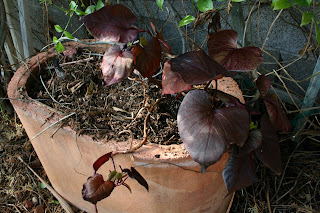 |
| (starter cells with broccoli, pak choi, kale, and chard) |
I generally start seeds on a monthly cycle, that way I've always got something going (or trying to get going). Using recycled nursery planting cells, I fill them up with fine, sifted compost soil. I set 1-2 seeds in each cell, top with soil, then pack gently. For simple record (since I've given up on maintaining a garden journal), I lay out my seed packets, make a date marker, and take a picture. I can later print this out and just tape it into my garden journal (so there).
 |
| (Loads of baby veggies soaking up some sun after the rain) |
So far from my december tinkerings, I have a beavy of lettuce, kale, chard and choi. I'll later thin them out (and attempt to transplant) once they're about 1"-2" inches tall, at approximately 30 days growth. I use a pump sprayer and water these guys 2-3 times a day when it's sunny.
I'm even doing some daring stuff with warm season crops like cucumbers, peppers, and tomatoes. Hopefully, the early start will give me some breathing room when spring season really warms up and EVERYTHING has to be done.
 |
| (Heirloom and organic tomatoes, peppers, and tomatillos) |
In addition to my edible seeds, I'm also working on perennial and wildflower seeds such as cosmos, echenacea, rudebekia, delphenium, hollyhock, salvia, and penstemon. I even managed to start some camomile (whoo-hooo! Finally after years of trying!)
 |
| (Here comes camomile!) |







.jpg)